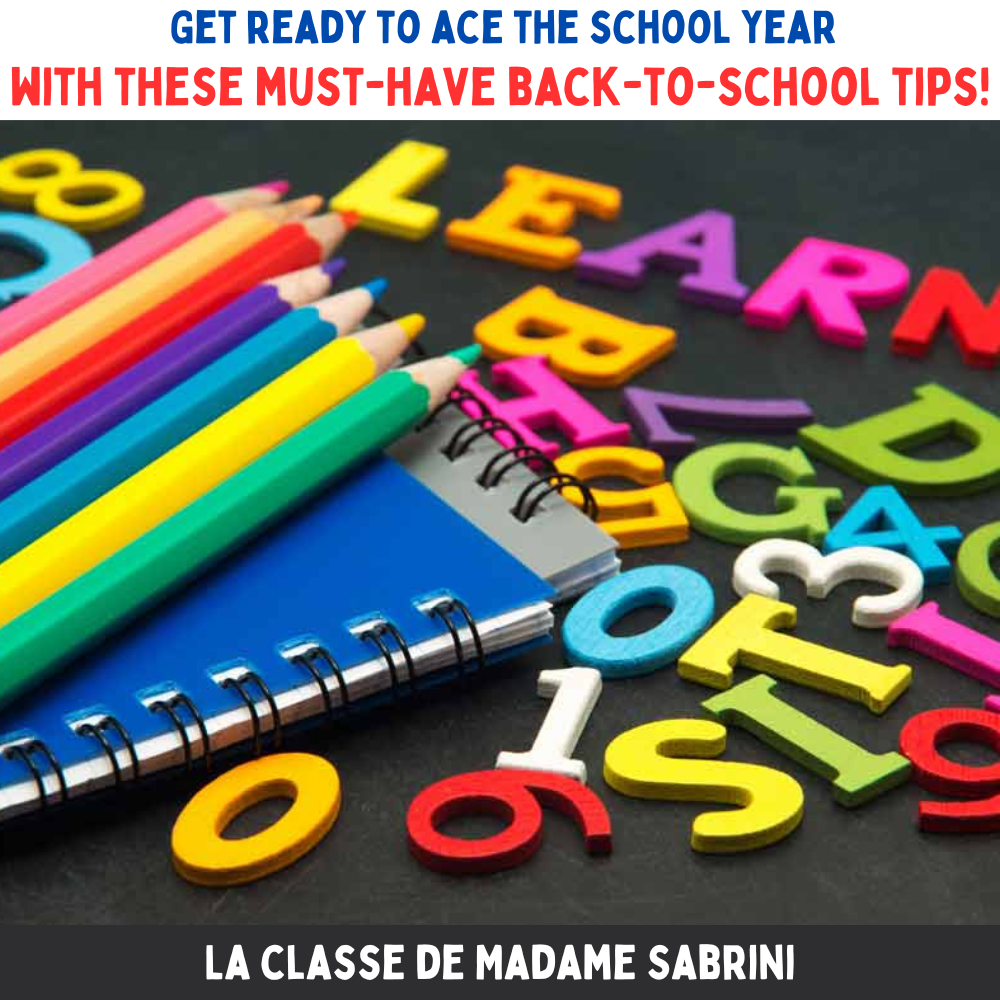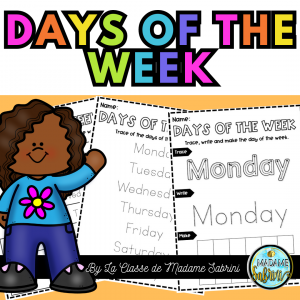This post may contain affiliate links which means I may receive a commission for purchases made through links. I will only recommend products that I have personally used! Learn more on my Private Policy page.
Going back to school can be an exciting but overwhelming time for teachers. After months of planning and preparing, the first day is finally here. To help make the transition smoother, here are 10 must-have back to school tips for every teacher. From creating a positive learning environment to building relationships with students, these tips will help ensure a successful start to the school year.
1) Setting up your classroom
Setting up your classroom is an essential part of preparing for the school year ahead. The way your classroom is organized and arranged can have a significant impact on your students’ learning experience. As a teacher, it’s important to create a welcoming and engaging environment that fosters a love for learning.
Start by thinking about the layout of your classroom. Consider the different learning areas you want to have, such as a reading corner, a writing center, or a math station. These areas should be clearly defined and easily accessible to your students. Use colorful posters, charts, and labels to make your classroom visually appealing and to help students find what they need.
In addition to the physical layout, make sure you have all the necessary materials and supplies ready for the first day of school. This includes textbooks, workbooks, art supplies, and any other materials specific to your grade level or subject. Having everything in its designated place will save you time and ensure a smooth transition into the school year.
Another important aspect of setting up your classroom is creating a sense of community. Display student work on bulletin boards, have a designated area for class discussions, and encourage collaboration among students. This will foster a positive and inclusive classroom environment.

2) Planning your curriculum
When it comes to planning your curriculum, it’s important to take the time to carefully map out what you will be teaching throughout the school year. This process not only ensures that you cover all necessary content but also helps you create a cohesive and engaging learning experience for your students.
Start by reviewing the curriculum guidelines and standards set by your school or district. This will give you a clear understanding of the content you need to cover and the skills your students should acquire. Take note of any specific topics or themes that need to be addressed and make a list of key concepts and objectives for each unit or lesson.
Next, consider the needs and interests of your students. Take into account their age, grade level, and previous knowledge. For example, if you are teaching kindergarten, you might focus on developing early literacy and numeracy skills through interactive and play-based activities. As a teacher, you have the flexibility to tailor your curriculum to meet the unique needs of your students.
Once you have a general outline of what you will be teaching, break it down into smaller units or lessons. This will help you structure your instructional time and ensure a smooth progression of learning throughout the year. Be sure to incorporate a variety of teaching strategies and resources to keep your lessons engaging and interactive.
Lastly, remember that planning your curriculum is an ongoing process. It’s important to regularly reflect on and revise your plans based on your students’ progress and feedback. Flexibility and adaptability are key as you navigate the school year, making adjustments as needed to meet the individual needs of your students.
3) Establishing expectations and routines
Establishing expectations and routines is crucial for creating a well-managed and productive learning environment. As a teacher, it is important to set clear expectations for your students from the very beginning. This includes academic expectations, such as completing assignments on time and actively participating in class discussions, as well as behavioral expectations, such as treating others with respect and following classroom rules.
One effective way to establish expectations is by creating a set of classroom rules together with your students. This gives them ownership and a sense of responsibility in maintaining a positive and respectful learning environment. Display these rules prominently in the classroom and refer to them regularly to remind students of the expectations.
Additionally, implementing consistent routines and procedures in your classroom helps to create a sense of structure and predictability for your students. For example, have a consistent routine for starting and ending the day, transitioning between subjects, and distributing materials. Clearly explain these routines to your students and provide them with ample opportunities to practice and reinforce them.
Kindergarten and elementary school teachers, in particular, should focus on establishing routines that support their students’ social and emotional development. This includes morning meetings to build community and set goals, designated sharing or show-and-tell time, and regular opportunities for students to reflect on their learning and emotions.
4) Building relationships with students
Building strong relationships with students is a fundamental aspect of being a teacher. When students feel valued, understood, and supported, they are more likely to engage in their learning and succeed academically. As a teacher, it’s important to make an effort to connect with each and every student in your classroom, regardless of their age or grade level.
In kindergarten, building relationships with students is especially crucial. For many of these young learners, school may be their first experience in a formal educational setting. They may be nervous, unsure, or even scared. As their teacher, it’s your role to create a warm and nurturing environment where they feel safe and comfortable.
Take the time to get to know your students on a personal level. Learn about their interests, hobbies, and family life. Show a genuine interest in their stories and experiences. Engage in conversations and ask open-ended questions to encourage them to share more about themselves.
Incorporate opportunities for cooperative learning and group activities where students can interact with their peers. Encourage them to collaborate, problem-solve, and support one another. Provide a variety of learning experiences that cater to different learning styles and interests. This will help foster a sense of belonging and create a positive classroom community.
Building relationships with students is an ongoing process that requires patience, understanding, and genuine care. By investing time and effort into establishing strong connections with your students, you are not only creating a positive learning environment but also setting the stage for their long-term success in school and beyond.

5) Organizing your materials and supplies
Organizing your materials and supplies is an essential part of being a teacher. As the school year begins, it’s important to have all the necessary materials and resources readily available and organized for easy access. This not only saves time but also ensures a smooth and efficient classroom environment.
Firstly, start by taking an inventory of your materials and supplies. Check if you have enough textbooks, workbooks, art supplies, and any other materials specific to your grade level or subject. If you find that you’re running low on certain items, make a list and restock as needed.
Next, think about how you can best organize these materials. Consider using storage bins or shelves to keep everything neat and tidy. Use labels and color-coding systems to help you quickly locate items. For example, you can have separate bins for different subject areas or designate specific shelves for different types of materials.
In addition to physical organization, it’s important to have a system in place for managing and tracking student work. Consider having designated folders or bins for turning in assignments, graded papers, and other important documents. This will help you stay organized and ensure that you can easily find and return students’ work.
Lastly, make sure you have a plan for maintaining the organization throughout the school year. Regularly go through your materials and supplies to keep them updated and remove any unnecessary items. Encourage your students to help with the organization by teaching them how to properly return materials to their designated places.
6) Implementing effective teaching strategies
Implementing effective teaching strategies is crucial for maximizing student engagement and promoting successful learning outcomes. As a teacher, it is essential to utilize a variety of strategies to cater to the diverse learning needs of your students. By employing different approaches, you can create a dynamic and engaging classroom environment that promotes active participation and deep understanding.
One effective teaching strategy is differentiation, which involves tailoring instruction to meet the individual needs of students. By assessing students’ prior knowledge and understanding their unique learning styles, you can adjust your teaching methods, materials, and assessments to ensure that all students can access and comprehend the content.
Another effective strategy is incorporating hands-on and experiential learning opportunities. By providing students with real-world experiences and opportunities to apply their knowledge, you can enhance their understanding and engagement. For example, in a kindergarten science lesson on plants, students could plant and care for their own seeds, observe their growth, and record their findings in a journal.
Collaborative learning is another powerful strategy that fosters both academic and social growth. Encourage students to work in pairs or small groups to solve problems, discuss ideas, and share their knowledge. This promotes critical thinking, communication skills, and teamwork.
7) Incorporating technology in the classroom
In today’s digital age, incorporating technology in the classroom has become essential for keeping students engaged and preparing them for the future. As a teacher, it’s important to embrace the opportunities that technology presents and leverage its benefits to enhance the learning experience for your students.
One way to incorporate technology in the classroom is by using educational apps and software. There are countless apps and online programs available that cover a wide range of subjects and topics, catering to different grade levels and learning styles. These apps can provide interactive and engaging content, allowing students to learn at their own pace and in a way that best suits their individual needs. For example, in a kindergarten classroom, students can use interactive apps to practice early literacy and numeracy skills, such as letter recognition, counting, and simple addition.
Another way to incorporate technology is through the use of interactive whiteboards and multimedia presentations. These tools allow you to display and manipulate content in a dynamic and visual way, making it more engaging and accessible to students. You can use interactive whiteboards to create interactive lessons, play educational videos, and showcase student work. This not only enhances students’ understanding but also promotes active participation and collaboration.
Additionally, technology can be used to facilitate communication and collaboration among students. Online platforms and discussion boards can provide a space for students to share ideas, ask questions, and collaborate on projects. This promotes critical thinking, communication skills, and teamwork, while also encouraging students to take ownership of their learning.
8) Creating a positive classroom culture
Creating a positive classroom culture is essential for fostering a supportive and inclusive learning environment. As a teacher, it’s your responsibility to create a space where students feel safe, valued, and motivated to learn. Here are some strategies to help you establish a positive classroom culture.
First and foremost, create a sense of community in your classroom. Encourage collaboration and teamwork among students. Provide opportunities for them to get to know each other through icebreaker activities and team-building exercises. By fostering a sense of belonging, students will feel more comfortable sharing their ideas, asking questions, and supporting one another.
Promote a growth mindset in your classroom. Encourage students to embrace challenges and view mistakes as opportunities for learning. Teach them that intelligence and abilities can be developed through hard work and perseverance. By praising effort and progress rather than just the end result, you are promoting a positive attitude towards learning and resilience.
Model positive behavior and values. Show respect and kindness towards all students. Encourage empathy and understanding by discussing diverse perspectives and experiences. Create a classroom environment that celebrates differences and encourages open-mindedness.
Create clear and consistent expectations for behavior. Establish classroom rules and consequences together with your students, and refer to them regularly. Encourage students to take responsibility for their actions and hold them accountable for their behavior. By setting clear expectations, you are providing structure and promoting a sense of fairness and order in your classroom.
Finally, make learning fun and engaging. Incorporate hands-on activities, interactive technology, and real-world connections to make lessons more enjoyable and relevant. Show enthusiasm and passion for the subjects you teach. By creating a positive and engaging learning experience, students will be motivated to participate and succeed.
9) Communicating with parents and colleagues
Effective communication with parents and colleagues is essential for a successful school year. As a teacher, it’s important to establish open and regular lines of communication with parents to keep them informed about their child’s progress and any important updates or events happening in the school. This can be done through newsletters, emails, or parent-teacher conferences. By maintaining positive and proactive communication with parents, you can build trust and create a strong partnership in supporting the child’s learning and development.
In addition to communicating with parents, collaborating with colleagues is also crucial for a teacher’s success. Sharing ideas, resources, and strategies with other teachers can help enhance your own teaching practice and promote a culture of continuous learning. Collaborating with colleagues can be done through team meetings, professional development workshops, or even informal discussions during breaks. By working together, teachers can support each other’s growth and provide a more enriching learning experience for their students.

10) Taking care of yourself as a teacher
Teaching is a rewarding and fulfilling profession, but it can also be demanding and stressful. As a teacher, it’s important to prioritize self-care to ensure that you can show up as your best self in the classroom. Taking care of yourself not only benefits you but also has a positive impact on your students and the overall learning environment.
Firstly, make sure to prioritize your physical health. Get enough sleep, eat nutritious meals, and exercise regularly. Taking care of your physical well-being will give you the energy and stamina you need to navigate the demands of the school day.
Additionally, don’t forget about your mental and emotional well-being. Teaching can be emotionally challenging, so it’s important to find healthy ways to cope with stress. Take breaks throughout the day to relax and recharge. Engage in activities that bring you joy and help you unwind, such as reading, listening to music, or spending time with loved ones.
Furthermore, seek support from your colleagues and professional networks. Connect with other teachers who can understand and relate to your experiences. Share your challenges and successes, and learn from one another. Building a support system can provide valuable advice, encouragement, and a sense of camaraderie.
Lastly, remember to set boundaries and find a work-life balance. It’s important to take time for yourself outside of school. Prioritize your personal interests, hobbies, and relationships. Allow yourself time to recharge and rejuvenate so that you can bring your best self to the classroom each day.















